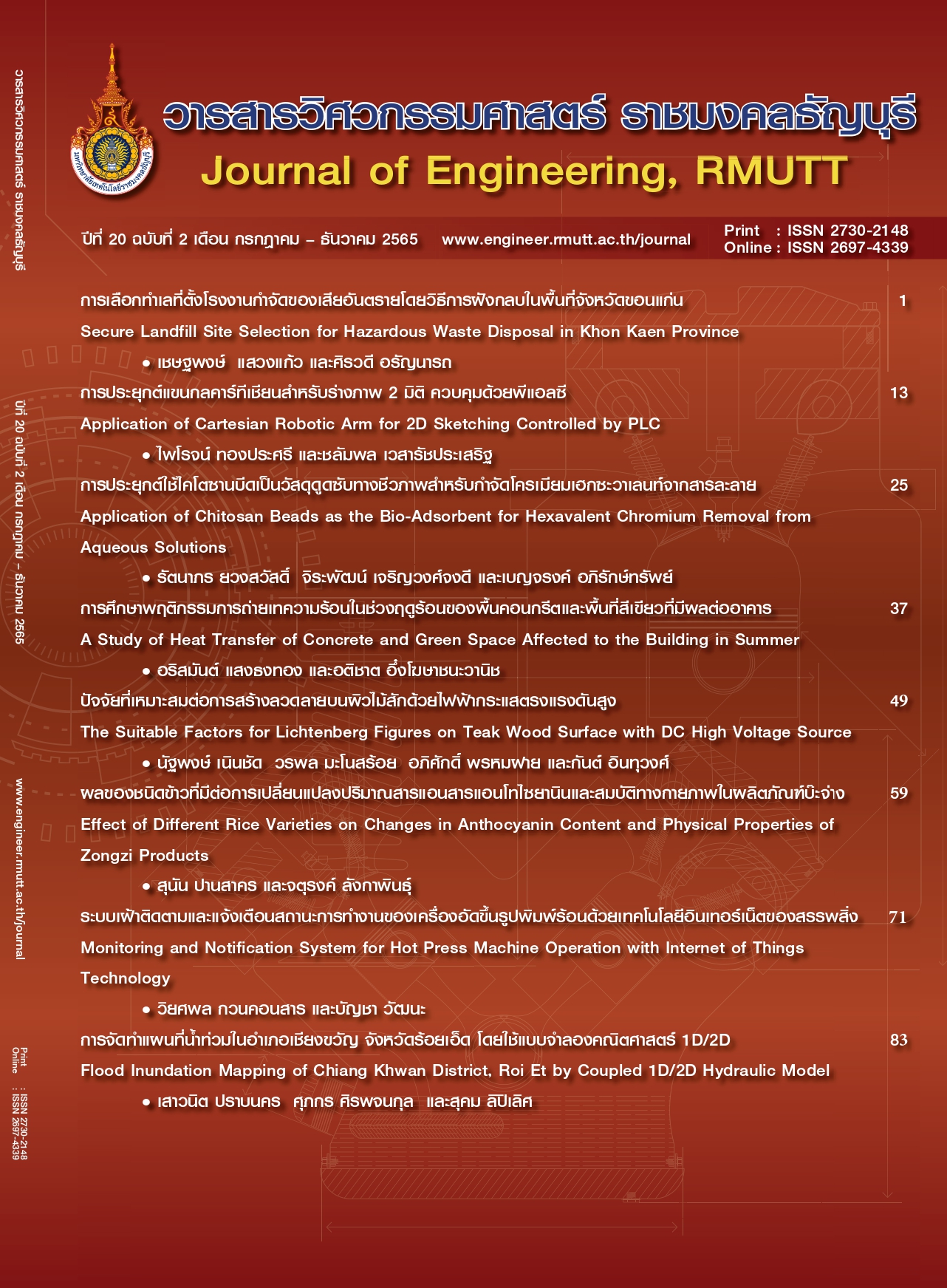Application of Chitosan Beads as the Bio-Adsorbent for Hexavalent Chromium Removal from Aqueous Solutions
Main Article Content
Abstract
The adsorption of chromium hexavalent (Cr6+) from synthetic wastewater using sodium tripolyphosphate - crosslinked chitosan beads was investigated. The adsorption of Cr6+ on chitosan beads was carried out in a batch experiment. The effect of parameters on the Cr6+ removal such as pH, initial Cr6+ concentration, adsorption temperature and adsorbent dosage were studied. The results showed that the removal of Cr6+ increased continuously in the first 20 min of adsorption and reached the equilibrium within 90 min. The Cr6+ removal was strongly affected by pH and the adsorption was favored in acidic solutions. The highest Cr6+ removal was obtained at the pH value of 2.0, initial Cr6+ concentration of 2 mg/L and chitosan beads dosage of 2 g. The adsorption efficiency of Cr6+ was 92 and 86% for chitosan beads and chitosan powder, respectively. Additionally, the adsorption isotherms and kinetics of Cr6+ adsorption on chitosan beads were studied. The adsorption isotherm and kinetics data were well fitted to Langmuir model and pseudo second-order model, indicating that the adsorption of Cr6+ on chitosan beads is a single layer chemisorption. This study showed that chitosan beads could be considered as an efficient bio-adsorbent for Cr6+ removal and easily separated from aqueous solutions.
Article Details

This work is licensed under a Creative Commons Attribution-NonCommercial-NoDerivatives 4.0 International License.
The manuscript, information, content, picture and so forth which were published on Frontiers in engineering innovation research has been a copyright of this journal only. There is not allow anyone or any organize to duplicate all content or some document for unethical publication.
References
Munter R. Industrial wastewater characteristics. Academia. [Internet]. 2003 [cited 2022 Sep 1];185-194. Available from: https://shorturl.asia/lRHd1
Akpor OB, Ohiobor GO, Olaolu TD. Heavy metal pollutants in wastewater effluent: Sources, effects and remediation. Advances in bioscience and bioengineering. 2014;2(4):37-43.
Peng H, Guo J. Removal of chromium from wastewater by membrane filtration, chemical precipitation, ion exchange, adsorption electro coagulation, electrochemical reduction, elec -trodialysis, electrodeionization, photocatalysis and nanotechnology: A review. Environmental chemistry letters. 2020;18:2055-68.
Mnif A, Bejaoui I, Mouelhi M, Hamrouni B. Hexavalent chromium removal from model water and car shock absorber factory effluent by nanofiltration and reverse osmosis membrane. International journal of analytical chemistry. 2017;1-10.
Jung C, Heo J, Han J, Her N, Lee SJ, Oh, J Ryu J. Hexavalent chromium removal by various adsorbents: powdered activated carbon, chitosan, and single/multi-walled carbon nanotubes. Separation and purification technology. 2013;106:63-71.
Meez E, Rahdar A, Kyzas GZ. Sawdust for the removal of heavy metals from water: A review. Molecules. 2021;26(4318):1-21.
Ajouyed O, Hurel C, Marmier N. Evaluation of the adsorption of hexavalent chromium on kaolinite and illite. Journal of environmental protection. 2011;2:1347-52.
Mehr MR, Fekri MH, Omidali F, Eftekhari N, Akbari-adergani B. Removal of Chromium (VI) from wastewater by palm kernel shell-based on a green method. Journal of chemical health risks. 2019;9(1):75-86.
Piyamongkala K, Sripakdee W. Kinetic and thermodynamic of chromium (VI) adsorption from electroplating wastewater by crosslinked chitosan resin. Research and development journal. 2009;20(3):87-98. (in Thai)
Hua C, Zhang R, Bai F, Lu P, Liang X. Removal of chromium (VI) from aqueous solutions using quaternized chitosan microspheres. Chinese journal of chemical engineering. 2017;25:153-8.
Siraj S, Islam MDM, Das PC, Masum SMD, Jahan IA, Shajahan MD. Removal of chromium from tannery effluent using chitosan-chacoal composite. Journal of Bangladesh chemical society, 2012; 25(1):53-61.
Nomanbhay SM, Palanisamy K. Removal of heavy metal from industrial wastewater using chitosan coated oil palm, shell charcoal. Electronic Journal of Biotechnology. 2005;8(1):43-53.
Yuangsawad R, Piyo S, Kasetniyom N. Chromium (VI) removal using crosslinked chitosan in fixed bed column. Journal of science and technology RMUTSB. 2021;5(1):11-22. (in Thai)
Bhumkar DR, Pokharkar VB. Studies on effect of pH on cross-linking of chitosan with sodium tripolyphosphate: A technical note. AAPS PharmSciTech. 2006;7(2):E1-6.
Gorzin F, Abadi BR. Adsorption of Cr(VI) from aqueous solution by adsorbent prepared from paper mill sludge: Kinetics and thermodynamics studies. Adsorption science & technology. 2018;36 (1-2):149-169.
Aydin YA, Aksoy ND. Adsorption of chromium on chitosan: Optimization, kinetics and thermodynamics. Chemical engineering journal. 2009;151:188-94.


